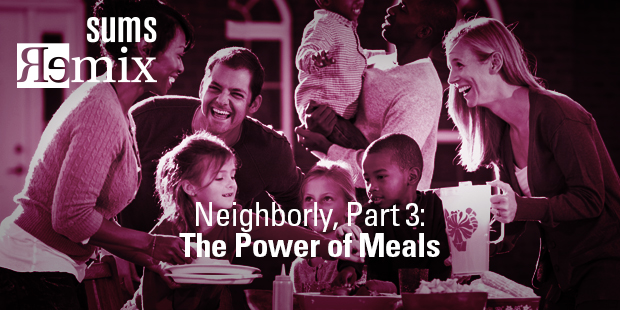
Neighborly, Part 3: The Power of Meals
The heart of God’s purpose for humankind is relationships – first, with God Himself; then, with one another. Arguably, there is no better place to build relationships than at the table with good food and great conversation.
Len Sweet, in his book From Tablet to Table states it eloquently:
Remember God’s first command in the Bible? Eat.
Remember God’s last command in the Bible? Drink.
And everything in between is a table – a life-course meal on which is served the very bread of life and cup of salvation.
It’s time to bring back the table to our homes, to our churches, and to our neighborhoods and the world.
The table is a recurring biblical theme, one that our fast-paced, drive-through, Instant Pot culture finds unfamiliar.
What would happen if we brought back the table as a sacred object of furniture in every home, church, and community?
Are we truly hungry to accept Jesus’ invitation – “Come and follow” – and to go wherever He leads, even if it means next door?
Especially if it means following Him next door!
What would it take for the table to return to the center of our family lives – and by extension, to those God has placed in our circle and situations?
THE QUICK SUMMARY – A Meal with Jesus: Discussing Grace, Community, and Mission Around the Table by Tim Chester
The meals of Jesus represent something bigger. They represent a new world, a new kingdom, a new outlook.
Tim Chester brings to light God’s purposes in the seemingly ordinary act of sharing a meal―how this everyday experience is really an opportunity for grace, community, and mission. Chester challenges contemporary understandings of hospitality as he urges us to evaluate why and who we invite to our table. Learn how you can foster grace and bless others through the rich fare being served in A Meal with Jesus.
A SIMPLE SOLUTION
Food matters. Meals matter. Meals are full of significance.
Food connects. It connects us with family. It turns strangers into friends. And it connects us with people around the world.
Our relationship with food is ambiguous. Television chefs have become celebrities and cookbooks regularly appear on bestseller lists. Yet we cook less than ever before. Americans spend over $50 billion on dieting each year – $50 billion to solve the problem of food gone wrong.
American Christians spend more on dieting than on world missions. We spend more on overconsumption than we do feeding the physically and spiritually hunger of the world.
We express who we want to be through food. Guess what? Jesus did too.
How did Jesus come? He came eating and drinking.
This is how Luke describes Jesus’ mission strategy: “The Son of Man came eating and drinking.” (Luke 7:34)
Jesus’ mission strategy was a long meal, stretching into the evening. He did evangelism and discipleship around a table with some grilled fish, a loaf of bread, and a pitcher of wine.
Luke’s Gospel is full of stories of Jesus eating with people:
Meals as Enacted Grace: In Luke 5, Jesus eats with tax collectors and sinners at the home of Levi.
Meals as Enacted Community: In Luke 7, Jesus is anointed at the home of Simon the Pharisee during a meal.
Meals as Enacted Hope: In Luke 9, Jesus feeds the five thousand.
Meals as Enacted Mission: In Luke 14, Jesus is at a meal when he urges people to invite the poor to their meals rather than their friends.
Meals as Enacted Salvation: In Luke 22, we have the account of the Last Supper.
Meals as Enacted Promise: In Luke 24, the risen Christ has a meal with two disciples in Emmaus, and then later eats fish with the disciples in Jerusalem.
So the meals of Jesus represent something bigger. They represent a new world, a new kingdom, a new outlook. But they give that new reality substance.
They represent friendship, community, and welcome.
Tim Chester, A Meal with Jesus: Discussing Grace, Community, and Mission Around the Table
A NEXT STEP
Devote an extended period of time over several weeks to the Bible passages listed above. In your journal or digital notes, create separate pages for each of the passages.
As you spend time reading and praying through them, write down what God is revealing to you, not only in personal growth but also in practical application.
Hospitality involves welcoming, creating space, listening, paying attention, and providing. Meals slow things down. Some of us don’t like that – we like to get things done.
However, meals force you to be people-oriented instead of task-oriented. Sharing a meal is not the only way to build relationships, but it is number one on the list.
Grace, mission, and community are never enacted best through programs, but rather through the equality and acceptance experienced at the common table.
Excerpt taken from SUMS Remix 103-3, released October 2018.
This is part of a weekly series posting excerpts from one of the most innovative content sources in the church world: SUMS Remix book excerpts for church leaders.
SUMS Remix takes a practical problem in the church and looks at it with three solutions; each solution is taken from a different book. Additionally, a practical action step is included with each solution.
As a church leader you get to scan relevant books based on practical tools and solutions to real ministry problems, not just by the cover of the book. Each post will have the edition number which shows the year and what number it is in the overall sequence. (SUMS Remix provides 26 issues per year, delivered every other week to your inbox).
> > Subscribe to SUMS Remix <<

Tags: A Meal with Jesus, Hospitlity, Tim Chester, food, meals












